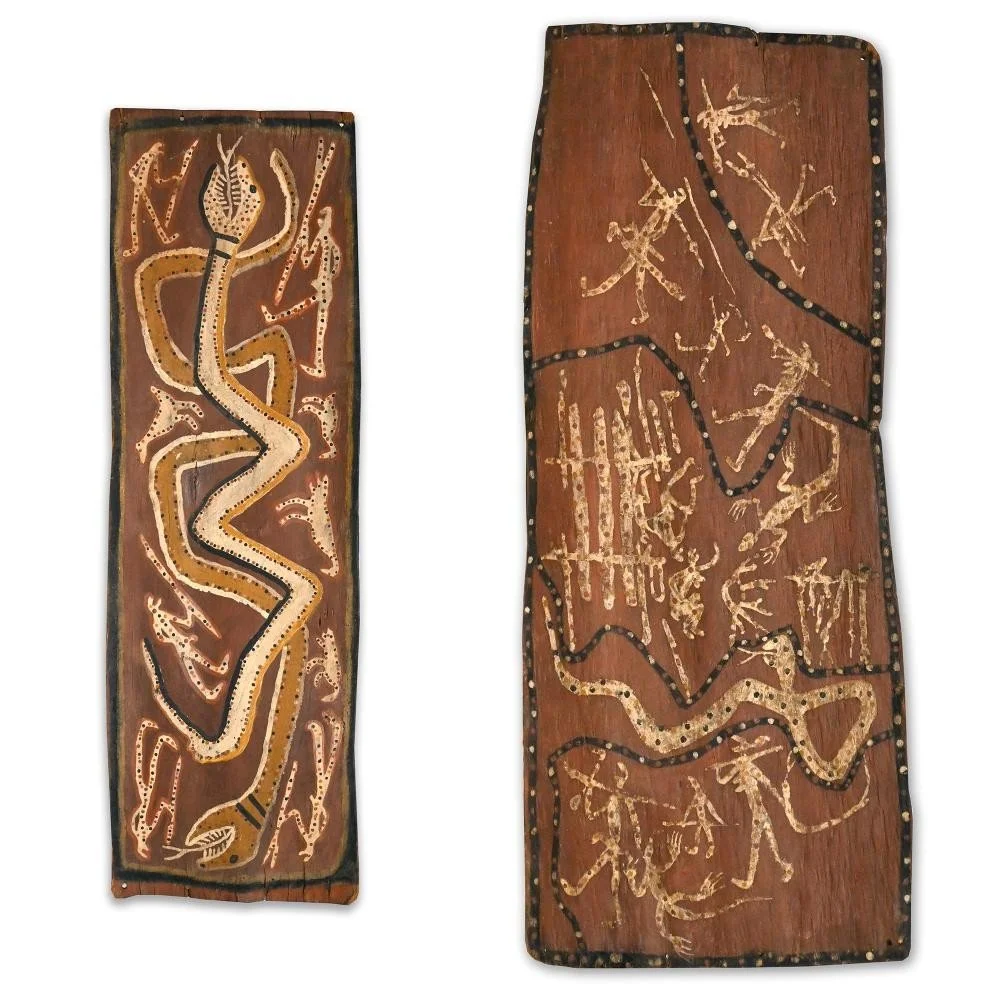
Artist: Paddy Wainburranga Fordham| Title: Waditj and Bolong | Year: c.1980 | Medium: natural earth pigments on bark | Dimensions: 73 x 30cm and 63 x 19.5 cm
PROVENANCE
Purchased from the artist c.1980, NT
Private Collection, WA
Private Collection, QLD
Cooee Art Gallery Indigenous Fine Art Auction, October 2022, Lot no. 77
ARTWORK STORY
Paddy Fordham was the leader of the Rembarrnga people and an artist of great renown whose career was notable for a number of major episodic works. In these two paintings he depicts Bolong, the Rainbow Serpent and how Waditj - the Rock man turned into stone.
The image of Bolong explains how indigenous society is divided into two separate moieties and a number of different skin groups.
In the episodic bark that accompanies it, Waditj is shown living with his clan in the Wybalk country. He was a devil man - very cruel and greedy. One day he decided to fulfil his desire to create more havoc in the world. He told his people that he was leaving to see what he could take from the nieghbouring tribes.
On his journey. Waditj came to a billabong and could hear songs from the Wagilag Sisters Dreaming being sung by people of the Ngalbon clan. As he got closer he began to feel heavy and found it hard to move. Black stone-like lumps began growing all over his body. Rembarrnga people say that Waditj was punished for his evil and was turned into a rock by the Bolong (Rainbow Serpent), the most powerful spirit of all.
Artwork story from Cooee Art Gallery certificate of authenticity.
Artist Profile
COMMUNITY/REGION
Beswick, NT
LANGUAGE
Rembarrnga
BIOGRAPHY
During his lifetime, renowned artist, dancer, didgeridoo player and storyteller, Paddy Fordham Wainburranga embodied the living history of the people of Australia’s far north. Born in the bush at Bumdubu, near Bulman, north east of Katherine, Paddy lived a totally traditional life, learning the ancient customs and Dreamtime stories from his father and uncles. He first encountered whites at the age of eleven when, with European settlement encroaching on their lands, the Rembarrnga people were settled at Maningrida… Continue Reading
PROVENANCE
Purchased from the artist c.1980, NT
Private Collection, WA
Private Collection, QLD
Cooee Art Gallery Indigenous Fine Art Auction, October 2022, Lot no. 77
ARTWORK STORY
Paddy Fordham was the leader of the Rembarrnga people and an artist of great renown whose career was notable for a number of major episodic works. In these two paintings he depicts Bolong, the Rainbow Serpent and how Waditj - the Rock man turned into stone.
The image of Bolong explains how indigenous society is divided into two separate moieties and a number of different skin groups.
In the episodic bark that accompanies it, Waditj is shown living with his clan in the Wybalk country. He was a devil man - very cruel and greedy. One day he decided to fulfil his desire to create more havoc in the world. He told his people that he was leaving to see what he could take from the nieghbouring tribes.
On his journey. Waditj came to a billabong and could hear songs from the Wagilag Sisters Dreaming being sung by people of the Ngalbon clan. As he got closer he began to feel heavy and found it hard to move. Black stone-like lumps began growing all over his body. Rembarrnga people say that Waditj was punished for his evil and was turned into a rock by the Bolong (Rainbow Serpent), the most powerful spirit of all.
Artwork story from Cooee Art Gallery certificate of authenticity.
Artist Profile
COMMUNITY/REGION
Beswick, NT
LANGUAGE
Rembarrnga
BIOGRAPHY
During his lifetime, renowned artist, dancer, didgeridoo player and storyteller, Paddy Fordham Wainburranga embodied the living history of the people of Australia’s far north. Born in the bush at Bumdubu, near Bulman, north east of Katherine, Paddy lived a totally traditional life, learning the ancient customs and Dreamtime stories from his father and uncles. He first encountered whites at the age of eleven when, with European settlement encroaching on their lands, the Rembarrnga people were settled at Maningrida… Continue Reading






